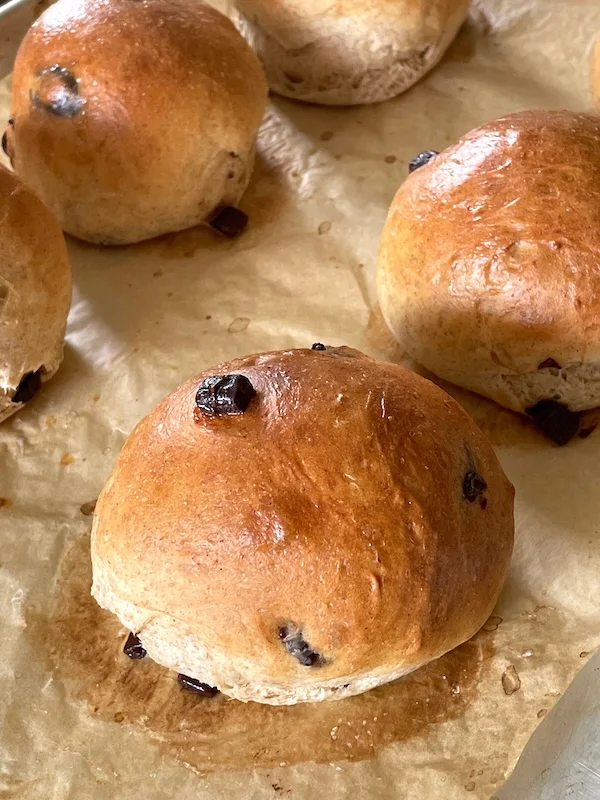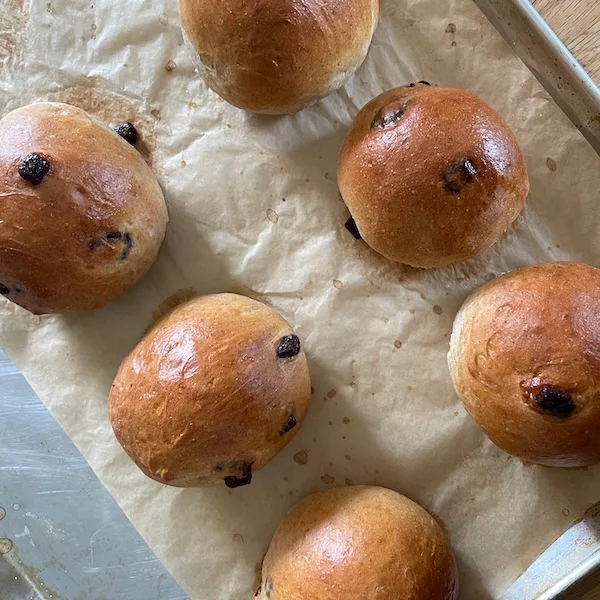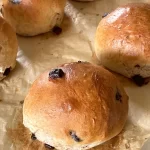Sweet soft buns made with table cream and studded with chocolate chunks. The dough is leavened with both sourdough starter (or discard) and instant yeast.

Want a similar soft bun recipe made with cream? Try these Table Cream Raisin Buns Recipe – Super Squishy
Replacing milk and butter with cream – why and how it works
For a while, I had been toying with the idea of using cream in an enriched dough instead of milk and butter. After all, cream is basically milk and butter in their original form before separation, so logically, should work. Because I despise softening butter and I had a carton of cream, I wanted to test out this experiment. What’s more, replacing two ingredients with one ingredient is always a good idea in my book of low-effort commandments.
The reason that most enriched bread recipes add softened butter after kneading the other ingredients first is because of (drumroll) gluten development. It is always about gluten development. Since fat coats gluten strands, it acts as both a shortening and lubricating agent. This means that paradoxically, fat shortens the gluten strands and also helps the gluten strands to expand. The way to optimize this is to first adequately develop gluten strands before adding fat.
Anyways, that’s all just theory (really vague ones at that) and I am not convinced that using cream will not work. Does anyone really know exactly how much fat shortens or lubricates/expands gluten? Like, an actual measurable number?
Further reading
Here are some other blog posts re butter and when to add it to dough. Overall conclusion seems to be that fat can be added at the beginning if it is of a low enough percentage.
- A blog post showing what happens when you mix fat in the beginning of the dough, suggesting that butter should be added after gluten development if it is more than 5%: https://wheatbeat.com/enriched-dough-mixing
- A video blog comparing butter added in melted, softened, and chilled form, finding all three to be comparable when added at the beginning of the dough mixing (but finding bad results when egg and sugar are also included): https://www.chainbaker.com/states-of-butter
- A scholarly article on the topic of how fat affects bread: see in particular 4.1 “Bread Fats” – milk fats “brace the developed gluten network as a plasticizer; […] align themselves to the gas–liquid interface of bubbles during dough mixing, exerting lubricating effects; [… and] enhance the stability index of bread dough.”
In this current recipe for buns made with cream, we are using table cream which has 18% milk fat. The total milk fat content is around 8% of the flour weight. This is not accounting for the fat in the eggs.
These buns had adequate (even good!) gluten development. I am not sure at what fat percentage it will become ill-advised to add fat at the beginning of dough mixing, but it definitely still works for my bun recipe using table cream (which has less than 10% fat). In fact, the low effort to reward scale heavily tilts in that favor. After all, the urge to avoid softening then adding butter bit by bit was why I developed this recipe!

Developing the recipe for these chocolate buns made with table cream
The starting point for these rolls came from a recipe for chocolate buns by Danish Baking Girl.
On a whim, I radically altered the original recipe (sorry!) to test out my idea of baking buns with cream instead of milk+butter.
Admittedly I did not read the recipe closely before setting out to make it, so the method is pretty much completely altered also. (On closer inspection now, Danish Baking Girl’s bun recipe calls for crumbling butter into flour, a technique which I’ve never tried in breadmaking.)
Remember that Tiktok trend for pouring cream over cinnamon rolls before baking? I bought some cream a couple of weeks ago with the intention of trying that out and never did. So I had a one liter carton of table cream in the fridge to slowly work through before expiration date. (It’s still there in my fridge weeks later…)
The original recipe called for 6 ¾ oz milk and 100 g butter. Google converted 6.75 oz to 190 grams, which I used to measure my cream. I had been neglecting my sourdough starter, so I fed it that day and put some in as an afterthought. It is well known that sourdough starters might develop depression due to neglect and thus lack the energy to rise future bread.
After the dough was already in the mixer, I realized that I had made a mistake in my calculation and forgot to account for the butter. It had been a tiring day, and it was evident that my brain was short circuiting a bit. Not only did I lose my ability to math, but I also spilt water, bumped my elbows and knees, and made a general mess in the kitchen.
Hastily, I scalded some flour with boiling water (too much water) and added this to the dough in an attempt to fix the hydration level to some extent. I call it a yudane and it works on the same principle but my ratios for flour/water are atypical.
When the buns came out of the oven, I fully expected them to be terrible (or at least middling) through nobody’s fault but my own. Instead, they were surprisingly soft and lovely!
I had one with butter and my mood improved thereafter (bread is known to have that effect).

Baker’s percentage
| Ingredient | Weight (grams) | Baker’s Percentage |
|---|---|---|
| Flour (bread flour + spelt) | 404 | 100 |
| Table cream (18 % MF) | 188 | 46.5 |
| Eggs | 100 | 24.7 |
| Sourdough starter | 50 | 12.4 |
| Salt | 4 | 0.9 |
| Spices | 3 | 0.7 |
| Chocolate | 125 | 30.9 |
| Water (boiling) | 27 | 6.6 |
Suggested baking schedule
A rough guideline to help you plan your own baking schedule. Proofing and baking time may vary depending on your ambient room temperature, bread proofing temperature, and the size of your buns. The buns take around 2.5-4 hours from start to finish.
12:45: Mix dough.
1:00: proof dough (bulk ferment)
2:30: Divide and form into rolls.
2:45: Begin final proof.
3:15: Preheat oven.
3:30: Bake!
3:45: Out of the oven, ready for fika!
Storage
Buns, as with any bread, are best enjoyed the day of but keep well for days to come.
For storage, I placed the buns in a container. They went in the fridge on the second day.
Twenty seconds in the microwave is all a bun needs to be warmed up. Once refreshed, the bun becomes pillowy again. The chocolate chunks melt and leaves their mark on our fingers and faces.
An aside re free spirited cooking
Years ago, my mom was making soup from a rarely used recipe book. I should tell you that the soup she makes most often is 罗宋汤 (pinyin: luo song tang) – Chinese-style Russian soup comprised of cubes of beef, onions, carrots, tomatoes, potatoes, and sometimes celery. It’s a basic, comforting soup that is a staple in our household. My mom could make this soup from muscle memory alone. She could probably make this soup without her glasses on (her prescription is very high).
Continuing with the story, she was making a soup out of a recipe book. I don’t remember what recipe she was using, but it was certainly not luo song tang – Chinese-style Russian soup. As she was partway through the recipe she went “Oh, I got some nice tomatoes yesterday, I can put that in”. The recipe did not call for tomatoes. And then soon after she would call me over: “Helelen! Bring over the potatoes in the fridge for me”. When it was dinner time the soup that was served had no semblance to the one in the recipe book. In fact, it looked exceedingly like luo song tang (罗宋汤- Chinese-style Russian soup). And it would continue to be like this, whatever new soup she set out to make from the recipe book always became luo song tang in the end. It was one of those mildly inconvenient curses.
In fact, it must have been a mildly inconvenient family curse because I too find it extremely hard to follow a recipe line by line and my future children will also one day set out to make macarons and instead turn up with amaretti I’m sure.
When I was growing up, I used to haunt Allrecipes as a leisure activity. It would not be uncommon to see multiple reviews along the lines of: “These muffins turned out so bad! They were way too dry – I added applesauce instead of butter and halved the sugar and used gluten free flour and also I did not have sour cream so I skipped that, but otherwise I followed the recipe to a T!”
Or the other side of the same coin: “This recipe is fantastic! My whole family raved about it: moist and delicious. I increased the butter to ½ cup, replaced the white sugar with brown sugar and made these other five changes but otherwise did not change the recipe!”
Certainly, all relatable behavior, but misplaced as reviews since the recipe was not actually made. But isn’t that just as well? After all, sometimes recipes are followed, other times recipes inspire.
Chocolate Buns (with table cream, no milk, no butter)
Ingredients
- 188 g table cream
- 2 eggs (100 g) beaten, reserve one tablespoon for eggwash
- 100 g whole spelt flour
- 300 g bread flour
- 8 g instant yeast one packet
- 50 g sourdough starter or discard
- ¾ tsp salt (4 g)
- 1 tsp cinnamon
- ½ tsp cardamom see note 1
- 125 g chocolate chunks or chips
For the yudane
- 1/2 tbsp 4 g flour
- 27 g boiling water
Instructions
- Combine everything except for the yudane ingredients and chocolate chunks in a stand mixer. Mix on low to combine, then mix on low-medium speed for 5 minutes.
- Meanwhile, make the yudane by combining the flour and boiling water and giving it a good mix.
- Add the yudane to the dough and knead until dough passes (or almost passes) windowpane test (around another 5-10 minutes). If this is difficult, it may help to mix/knead the dough in 5 minute segments and allow the dough to relax in between.
- Once the dough is sufficiently developed (i.e. more or less passes the windowpane test), add the chocolate chunks and knead or fold to combine evenly.
- Let the dough rest covered, in a warm place until almost doubled (about 1.5 hours for me).
- After dough has finished bulk fermentation, divide into 8-10 equal pieces (8 will give big buns). Form the divided dough into round spheres, tucking in the skin in a rolling motion with your hand. Place the formed buns onto a baking tray lined with parchment paper, leaving ample room for expansion. If you are not covering the buns, brush the buns with the reserved 1 tablespoon of beaten egg (adding a bit of water to thin the egg out) so that they do not dry out during proofing. If you are covering the buns during final proofing, brush the eggwash while the oven is preheating.
- Proof until dough is puffy and almost doubled. If you poke the dough gently, it should not bounce back immediately. If you shake the tray, the dough should jiggle somewhat.
- Preheat oven to 365 degrees F 15 minutes before you are ready to bake. If you still have egg wash leftover, brush the remainder on the buns while the oven is preheating.
- Bake the buns for 15 minutes, buns should be lightly golden brown.
Notes
Subscribe to my newsletter
(Sporadic) updates on new posts and recipes sent straight to your inbox.

Leave a Reply